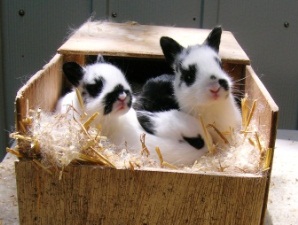This article explores how condition should be evaluated when judging rabbits. You can also learn what you can feed your rabbit to condition it for show at this page.
What is Condition in Show Rabbits?
by Laurie Stroupe
Our standard refers to the ARBA definition of condition. Have you ever read it? I hope so! But if not, here it is:
* “Condition – All animals . . . are to have a definite appearance of health and vigor. They are to be bold and bright of eye. All animals are to have a good coat, firmly set in the pelt. They are to be firm in flesh covering, neither too fat, with soft, flabby flesh, nor too thin in flesh, creating a bony effect when examined. Flesh is to be deep and even over the entire body.”
(If you don’t have a copy of the Standard of Perfection, you can order one at the ARBA website.)
Be Firm… in Flesh
We often talk about how good a rabbit feels. When we start out in rabbits, we often have just the idea that some things feel pleasant in our hands and some don’t. But over time, we need to develop our ability to evaluate our rabbits based on feel.
I think that one of the most problematic areas we as breeders have is mistaking fat for good flesh. Having firm flesh is not just a matter of not being able to feel boniness when we run our hands over a rabbit. The flesh should be firm.
With rabbits, we can often grasp loose, flabby fur and flesh in our hands on the side of a rabbit. This rabbit may not feel bony, but it still doesn’t have the flesh we are looking for.

You also want a covering of flesh over the spine. You can expose the spine by dehydrating a rabbit. Rabbits in very poor condition expose their spines, too. But if you have firm flesh elsewhere and the spine is still bony, you may be genetically reproducing the problem.
If you are still confused about what you are looking for, find a commercial rabbit breeder that is successful. While Holland lops are never going to be New Zealands, feeling one of those rabbits, whose breeding has concentrated heavily on flesh production, will give you a better idea of what good flesh is like.
Another place that often confuses us is the disguise that a very dense fur can cause. Think of a chicken carcass. It’s definitely bony, right? Now cover it with your coat (gross). Do that mentally. It would be really messy otherwise. Wouldn’t it feel a lot less bony? Now cover it (mentally) with a cloth napkin. Wouldn’t that feel more bony?
We can tell a lot about a rabbit by just looking at it in its coop. We should never underestimate the power of standing back and taking a good look. But the value of feeling rabbits should not be overlooked. You can tell a lot about a rabbit with your eyes tightly shut.
So look and feel for firm rabbits with good flesh, tight coats, and good spine covering. Go for a dense coat, of course, but don’t confuse that with good flesh.
How important is condition?
[Editor’s note: this varies by breed. Condition affects coat and color as well as “condition,” so in breeds where coat and color matter, condition can be a big deal. The following notes are Laurie’s opinions on how condition should be weighted in Holland Lops, where fur, color, and condition are NOT important factors according to the Standard. We would love more articles on how condition is important in your breed! Contact Us.]
The standard for Holland Lops allocates just five points to condition. That’s not really a lot and it shouldn’t make a huge difference to judges, right? Well, yes and no. Some of the same qualities that define condition also creep into the basic description of the body – especially where we see “well-filled” or “full.” There is also some overlap with the fur points of 7. “Even in length” can be disrupted by either the rabbit’s natural coat type or by fur condition, which is part of the overall condition standard.
So, if a judge marks down a rabbit in poor condition more than five points, he or she has plenty of room in the body and fur categories to borrow some.
I’ve also talked with judges who hold the opinion that, “With just five points on condition, I’d never keep a good Holland home.” In theory, I agree with that. But in practice, it doesn’t always work the way it should. Judges, being human, often have a hard time looking past condition issues. I was very impressed with a judge who once placed a sable point in horrible fur condition as Best of Breed. He checked the points and announced that he felt that the rabbit was the best even after deducting for condition. That’s the way it should be.
There are other reasons, of course, to keep rabbits home that are in poor condition. The number one reason would be that rabbits already in poor condition do not need the extra stress of traveling while they are trying to put on flesh or grow a new coat. You’d hate to stall out their recovery and delay the time when they can hit the table fit and in good fur.

